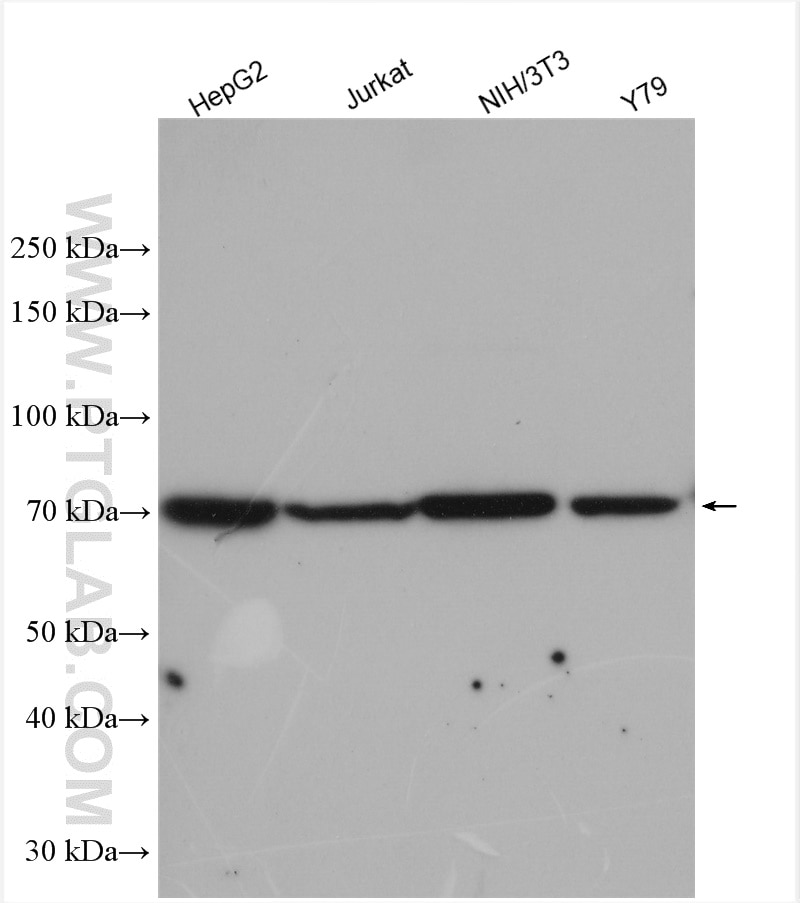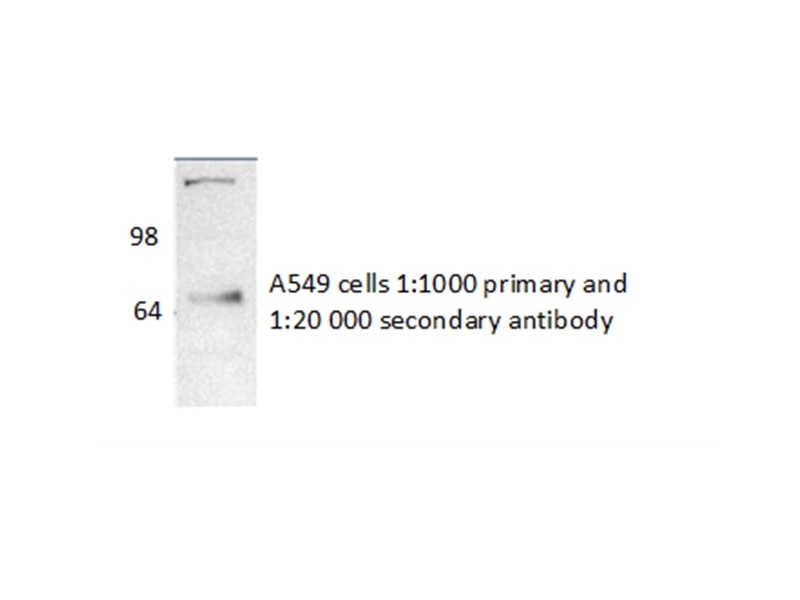Tested Applications
| Positive WB detected in | A549 cells, HepG2 cells, mouse skeletal muscle tissue, Jurkat cells, NIH/3T3 cells, Y79 cells, HeLa cells |
| Positive IHC detected in | mouse skeletal muscle tissue Note: suggested antigen retrieval with TE buffer pH 9.0; (*) Alternatively, antigen retrieval may be performed with citrate buffer pH 6.0 |
| Positive IF/ICC detected in | NIH/3T3 cells |
Recommended dilution
| Application | Dilution |
|---|---|
| Western Blot (WB) | WB : 1:1000-1:4000 |
| Immunohistochemistry (IHC) | IHC : 1:50-1:500 |
| Immunofluorescence (IF)/ICC | IF/ICC : 1:50-1:500 |
| It is recommended that this reagent should be titrated in each testing system to obtain optimal results. | |
| Sample-dependent, Check data in validation data gallery. | |
Published Applications
| KD/KO | See 5 publications below |
| WB | See 29 publications below |
| IHC | See 3 publications below |
| IF | See 6 publications below |
| IP | See 1 publications below |
| ChIP | See 5 publications below |
Product Information
14506-1-AP targets NR1D1 in WB, IHC, IF/ICC, IP, ChIP, ELISA applications and shows reactivity with human, mouse samples.
| Tested Reactivity | human, mouse |
| Cited Reactivity | human, mouse, rat, sheep |
| Host / Isotype | Rabbit / IgG |
| Class | Polyclonal |
| Type | Antibody |
| Immunogen |
CatNo: Ag5964 Product name: Recombinant human NR1D1 protein Source: e coli.-derived, PGEX-4T Tag: GST Domain: 1-350 aa of BC056148 Sequence: MTTLDSNNNTGGVITYIGSSGSSPSRTSPESLYSDNSNGSFQSLTQGCPTYFPPSPTGSLTQDPARSFGSIPPSLSDDGSPSSSSSSSSSSSSFYNGSPPGSLQVAMEDSSRVSPSKSTSNITKLNGMVLLCKVCGDVASGFHYGVHACEGCKGFFRRSIQQNIQYKRCLKNENCSIVRINRNRCQQCRFKKCLSVGMSRDAVRFGRIPKREKQRMLAEMQSAMNLANNQLSSQCPLETSPTQHPTPGPMGPSPPPAPVPSPLVGFSQFPQQLTPPRSPSPEPTVEDVISQVARAHREIFTYAHDKLGSSPGNFNANHASGSPPATTPHRWENQGCPPAPNDNNTLAAQR Predict reactive species |
| Full Name | nuclear receptor subfamily 1, group D, member 1 |
| Calculated Molecular Weight | 67 kDa |
| Observed Molecular Weight | 68 kDa |
| GenBank Accession Number | BC056148 |
| Gene Symbol | NR1D1 |
| Gene ID (NCBI) | 9572 |
| RRID | AB_11182604 |
| Conjugate | Unconjugated |
| Form | Liquid |
| Purification Method | Antigen affinity purification |
| UNIPROT ID | P20393 |
| Storage Buffer | PBS with 0.02% sodium azide and 50% glycerol, pH 7.3. |
| Storage Conditions | Store at -20°C. Stable for one year after shipment. Aliquoting is unnecessary for -20oC storage. 20ul sizes contain 0.1% BSA. |
Background Information
NR1D1, also named EAR1, THRAL, ear-1, and hRev, contains one nuclear receptor DNA-binding domain and belongs to the nuclear hormone receptor family. NR1 subfamily. This protein functions as a constitutive transcriptional repressor. It is a possible receptor for triiodothyronine. BMAL1-CLOCK activates Rev-erba itself and thereby represents the link between the positive and negative loops of the circadian clock. This is a rabbit polyclonal antibody raised against the N terminus of human NR1D1.
Protocols
| Product Specific Protocols | |
|---|---|
| IF protocol for NR1D1 antibody 14506-1-AP | Download protocol |
| IHC protocol for NR1D1 antibody 14506-1-AP | Download protocol |
| WB protocol for NR1D1 antibody 14506-1-AP | Download protocol |
| Standard Protocols | |
|---|---|
| Click here to view our Standard Protocols |
Publications
| Species | Application | Title |
|---|---|---|
Nat Commun The tight junction protein TJP1 regulates the feeding-modulated hepatic circadian clock. | ||
Theranostics PPAR-γ integrates obesity and adipocyte clock through epigenetic regulation of Bmal1. | ||
Cancer Res NR1D1 recruitment to sites of DNA damage inhibits repair and is associated with chemosensitivity of breast cancer. | ||
Int J Biol Macromol Dihydroartemisinin requires NR1D1 mediated Rab7 ubiquitination to regulate hepatic stellate cells lipophagy in liver fibrosis
| ||
Cell Death Discov NR1D1 deficiency in the tumor microenvironment promotes lung tumor development by activating the NLRP3 inflammasome | ||
J Neuroinflammation The circadian clock protein Rev-erbα provides neuroprotection and attenuates neuroinflammation against Parkinson's disease via the microglial NLRP3 inflammasome. |
Reviews
The reviews below have been submitted by verified Proteintech customers who received an incentive for providing their feedback.
FH Priya (Verified Customer) (01-17-2023) | I have used for cardiomyocytes, mouse skin and liver tissues
|
FH Satish (Verified Customer) (12-19-2019) | I got clear bands. The antibody detects two band one band around 67 kDa and another band much lower than 67kDa.
|




















